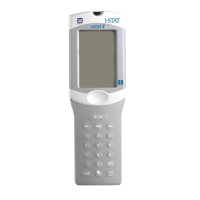3
Art: 714547-00F Rev. Date: 06/11/08
4. Obtain at least two 4.5 cc blue top (3.8% or 3.2% sodium citrate) tubes. Gently mix the tubes
end to end 10 times. (Note: a total of 9.0 mL of citrated whole blood is needed and pooled in
the larger collection tube)
5. Accurately dispense 0.70 mL of the citrated blood sample to each one of the seven test tubes
prepared in step 3. (“A”, “B”, “C”, “D”, “E”, “F” and “G”). These are the tubes to which the
heparin has previously been added. After adding the blood sample, gently mix the tubes by
inversion.
6. Starting with test tube “A” add 0.30 mL of 0.025M Calcium Chloride to the tube. Mix thoroughly.
(Do not add Calcium Chloride to the tube until ready to run the cartridge(s) for that heparin level.)
7. Immediately, use a plastic transfer pipet or a syringe to dispense the mixture into the sample well
of 2 ACT cartridges. Begin the test.
8. Record the ACT results.
9. Repeat steps 6 through 9 for all tubes “B”, “C”, “D”, “E”, “F” and “G”.
Note: Before testing tubes B – G, mix gently by inversion.
10. Record the clotting times and graph the results using, “Avg. ACT seconds” on the y-axis and
“Heparin Concentration” (units/mL) on the x-axis.
Result Interpretation
Inspection of the dose-response curve will identify a linear sensitivity response. Linearity is defined
statistically by the correlation coefficient (r value) of the assay, which should be ≥ 0.88.
Notes:
Due to the variability of heparin sensitivity, high levels may yield out of range high results. An intermediate
amount of heparin can be used to perform linearity (e.g. 35 μL). The actual values obtained for a given
heparin level will vary among donors. The heparin type (beef or porcine), manufacturer source and lot
number of the heparin preparation will also affect results. The maximum concentration of heparin at which
a donor’s blood will clot is dependent upon physiologic characteristics of the donor. Extremely elevated
clotting times can be excluded from the analysis.
LINEARITY PROCEDURE FOR USING FRESH WHOLE BLOOD
Materials
• i-STAT Celite ACT or i-STAT Kaolin ACT cartridges (14)
• Plastic test tubes, no additives (7)
• Large plastic collection tube for heparin dilution, 20 mL, no additives (1)
• 1,000 units/mL USP Heparin (beef lung or porcine)
• Isotonic Saline (9.0 mL)
• Precision pipettes (1,000 uL)
Procedure
1. Obtain 14 i-STAT ACT cartridges and at least two i-STAT Analyzers.
2. Using a standard pharmaceutical heparin preparation (either beef or porcine derived material
from any manufacturer), dilute the heparin using saline to a concentration of 100 units/mL of
total volume. This can be accomplished by adding 9.0 mL of saline to 1.0 mL of standard USP
heparin supplied at 1,000 units/mL.
3. Label seven (7) plastic test tubes in the following manner: “A”, “B”, “C”, “D” “E”, “F” and “G”.
4. Dispense the following quantities of the diluted heparin into the respective test tubes. The final
concentration of heparin in the plastic test tubes after the addition of 1.0 mL fresh whole blood
can be found in the table below.

